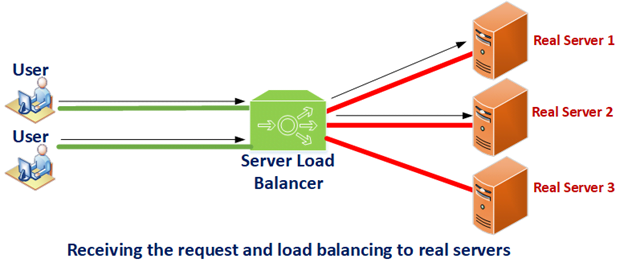Understanding Virtual Server To Real Server Load Balancing
To understand various load balancing methods, we will first know about the servers i.e., virtual server and a real server. This will help us to decide which load-balancing method will be most preferable in the network and then according to services, we can apply a suitable load balancing method for each virtual server.
What is a Server?
The server is the term that represents a group of devices, that will give you services. Services may be Information or resource. For example, when you are accessing any webpage for information or when you store any data in the cloud there will be servers who will be providing you services.
What do we mean by a Virtual Server and a Real Server?
A virtual server is a network device that will give a response on behalf of actual/real servers to all clients whosoever is generating a request for services.

The real server will be the actual server that will provide the actual service. A virtual server will receive the service request from a client and forward it to the actual server and receive the reply from the real server and forward it to the client.
What is a Server Load Balancer?
A virtual server will be hosted on a server load balancer. To increase the performance and to provide the services 24X7 we will use multiple real servers so that if one goes down others can provide the services to the user. Multiple real servers will increase the hardware resources for better performance. So, the server load balancer will receive a request from a client, and it will balance the load between multiple real servers.

Note: For HA we will deploy multiple server load balancers in a cluster for that we can get redundancy on the server load balancer level. Also, we will host multiple virtual servers in the same cluster for proper hardware utilization.
Round-Robin Load Balancing
Round robin load balancing is a way to distribute client requests across a group of real servers. A client request is forwarded to each server in turn. The algorithm instructs the load balancer to forward the client request to real server 1 and when the next request comes from the client Server load balancer will forward the request to real server 2 and this process will continue and when the request forward to the last real server, next request will be forwarded to real server 1 and this process will repeat again.
Weighted Load Balancing
Suppose there are 3 real servers mapped with one virtual server, and we will set weight for each real server, and the server load balancer will calculate the ratio of the real server’s weight and forward the traffic accordingly. For example, if the ratio is 1:2:3 then the server load balancer will forward the first client request to real server 1 and the next 2 client requests will be forwarded to real server 2 and the next 3 client requests will be forwarded to real server 3. This process will repeat again.
Least Connections Load Balancing
In this load balancing method, when any client request will be received by the server load balancer it will check which real server will have the least connection, and then forward the request to the real server which has the least connection.
Fastest Response Load Balancing
In this load balancing, method the server load balancer will check which real server will provide the fastest response, and accordingly server load balancer will set priority and distribute the client requests among the real servers.
What are the Advantages of Server Load Balancing?
Increased efficiency for server utilization and network bandwidth
A server load balancer is aware of the multiple real servers mapped with a virtual server and can then balance user session traffic among the available real servers.
Increased reliability of services to users
If any real server associated with the virtual server fails, the remaining real servers continue to provide services to the client. So, the client will get services without interruption.
Increased Scalability of Services
Day by day users can be increased as per the demand of service, so we can add more real servers and mapped those with the same virtual server. So, without any interruption, we can starch our hardware resources as per the demand of service.
Zindagi technologies provide services like network design, implementation, and security services so that user has the fast access to the applications/services even if 2 out of 4 real server fails or are down, then also the user will get uninterrupted services. Give us a call at +91 9773973971 or contact us at Zindagi Technologies for any queries or related services.
Author
Dipayan Sarkar
Network Security Consultant
